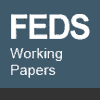
| Finance and Economics Discussion Series |
|---|
 |
Monetary Policy in a Stochastic Equilibrium Model with Real and Nominal Rigidities Jinill Kim 1998-2 |
Abstract: A dynamic stochastic general-equilibrium (DSGE) model with real and nominal rigidities succeeds in capturing some key nominal features of U.S. business cycles. Additive technology shocks, as well as multiplicative shocks, are introduced. Monetary policy is specified following the developments in the structural vector autoregression (VAR) literature. Interaction between real and nominal rigidities is essential to reproduce the liquidity effect of monetary policy. The model is estimated by maximum likelihood on U.S. data, and its fit is comparable to that of an unrestricted first-order VAR. Besides producing reasonable impulse responses and second moments, this model replicates a feature of U.S. business cycles, never captured by previous research with DSGE models, that an increase in interest rates predicts a decrease in output two to six quarters in the future. Finally, some policy implications are discussed.
Full paper (560 KB PDF)
| Full paper (628 KB Postscript)
Home | Economic research and data | FR working papers | FEDS | 1998 FEDS papers
Accessibility
To comment on this site, please fill out our feedback form.
Last update: January 16, 1998